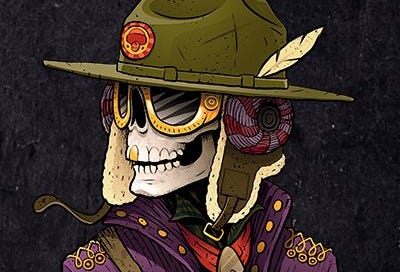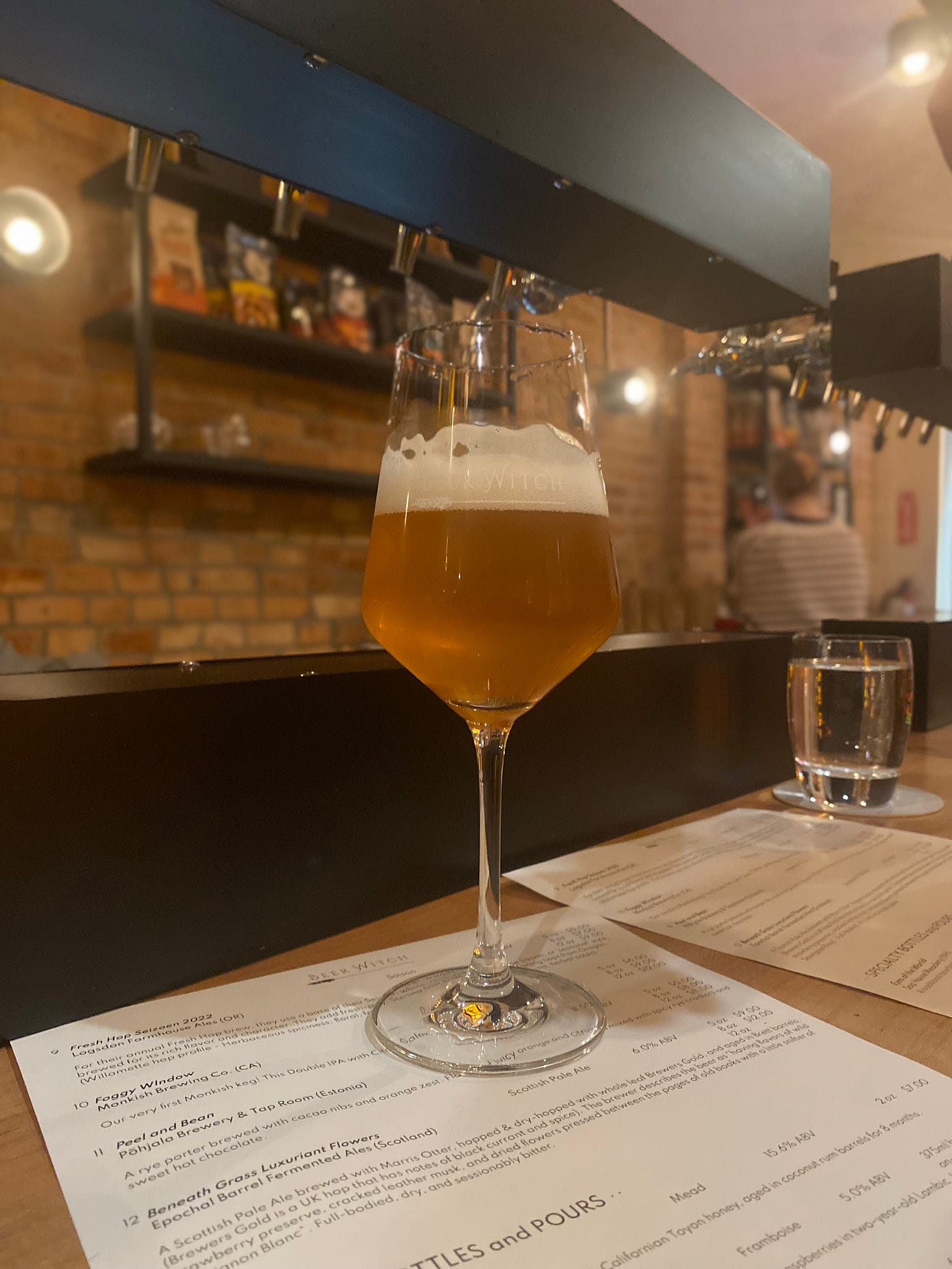79. This Is Our [Beer] Under Pressure
Sussing out the challenges facing craft beer now, how breweries will respond, and how this will all shape the industry; plus tarot for an "emotional support duck."
Crash, Boom, Consolidation, Over-Exaggeration, Bang: And So We Enter the Next Phase in Craft Beer
Depending on who you ask, this statement is either overly dramatic or totally duh: we are entering a new frontier in craft beer.
It’s a combination of factors, really, some that will presumably feel familiar to folks who have been at this a while, and some that are completely new to all of us. And some will feel inevitable, obvious, predictable…while others are shifts I’m willing to bet many of us couldn’t have guessed even a few years ago.
Lately, I’ve become interested in looking for coverage of what some refer to as the “craft beer crash” of the 1990s. I’m itching to dig into the specifics of that arc and find parallels as well as differences between what was happening then and what’s happening now. Because from what I understand, it looks pretty familiar, just with some varying contributing causes. The craft beer boom of the ‘90s—yes, hardly a “boom” compared to the proliferation of breweries in the last few years, but this was still part of the initial growth phase of modern American craft beer in the first place—outpaced demand. It felt rushed. Did everyone even know what they were doing? Aaron Goldfarb’s VinePair piece on the short-lived wave of Manhattan brewpubs is a helpful microcosm to look at here—some breweries were doing great things but consumers just did what they always do and got fickle, some breweries were good at beer but not at money, and some breweries were actually not so great at beer.
Over 20 years later, we’ve come full circle to a point of over-saturation. But the reasons behind a glut of competition are different. At the same time as it was setting into motion a domino effect of obstacles for independent breweries to overcome in order to survive, the pandemic’s early days also pushed hundreds (thousands? to varying degrees) of taproom breweries into focusing more on distribution than on, well, their taprooms. More breweries suddenly found themselves competing for shelf space that was, woops, already shrinking anyway to make room for hard seltzer and RTD cocktails.
I’m speculating based on the small amount of writing I could find on craft beer at the end of the 1990s, because at the time I was busy worrying whether being able to sing the entire score of “By Jeeves” would get me friends in high school, but I’d imagine competition 20+ years ago was driven by the fact that it was only a small proportion of drinkers who were well acquainted with craft beer, and maybe only another small set who were interested in becoming so. Multiplying breweries were competing for a (compared to today) diminutive amount of interest. Today’s drinker is informed. They know craft beer to at least some extent. But they also know about other drinks, and they’re making decisions based on all of this information—they’ve actually got options, and can buy according to preferences on flavor, ABV, cost, ingredients, even brand identity.
Less room + more breweries is far from the only problem, too. You know the words to this one by now, if you want to sing along—rising costs, supply chain issues, and people still drinking more at home, which often entails them shopping in chain retail, which often means they’re picking up seltzers, RTDs, or beer from the kind of breweries that have catalyzed the conversation around whether the term “craft” beer is even relevant anymore. I was recently interviewing some experts in the brewhouse equipment space for a story and it felt like every answer came back to, “Well, uh, do not try to start a production brewery anymore!” The name of the game now is “taproom breweries,” and you’d better make that taproom an experience in order to get people in there. The craft brewery landscape now feels to me more like the restaurant landscape. It’s probably safe to say 99%(?) of restaurants have no plans to try to sell menu items outside their location (Goldbelly aside). That’s not the tidiest of links, as I think many, many breweries can and still will distribute their beer in some capacity. But fixing to be the next big regional brewery is probably not the most sound ambition ~in this economy.~
With a tiny tier of breweries becoming the main sellers across the country and the rest turning into more local, individualized destinations, that middle area where you can be a decently sized brewery, still giving off ~cool taproom brewery~ vibes but also distributing in multiple states is disappearing. If you’re doggedly dedicated enough to cling onto some of that middle-tier status, you’ve got to take your notes from breweries like Other Half or Urban South, finding attractive opportunities to grow into mini-chains, leveraging a widespread physical footprint into widespread consumer awareness and therefore better retail performance odds.
Between those mid-level breweries disappearing, getting bought by others, downsizing and/or partnering with others, and only a true handful of breweries rising to or remaining in a comfier space of national recognition…forget the ‘90s crash, are we getting mid-20th century consolidation?
It’s hard to imagine such a scenario being realistic now. For one thing, the industry’s gotten so complex, with mergers and acquisitions coming in from all angles—not just Big Beer, but Big Beverage, international holdings companies, and partnerships and collectives formed among smaller craft breweries. For another, we love our breweries. Breweries have woven themselves into society and the way we do leisure. They’re true third places, more so than bars because of the fact they’re more family-friendly, and many tend to be hubs of community activity. Even as we lose a segment of them to the current challenges and pressures, it seems unthinkable that we’ll collectively just lose interest in craft breweries to the point there’s no reason for at least enough to exist to cover different neighborhoods across the country, and that’s a lot. Besides, for all the shifting interests to other beverage categories, I think it’s way too soon to declare craft beer anything close to down for the count. There’s plenty of potential for growth still, even if it means breweries stretching into non-beer avenues like hard seltzer, RTDs, non-alcoholic beer, even wine in order to support their pesky beer-making habit.
And to come back to the whole question of whether certain proclamations are dramatic, consider what number we are in fact talking about when we throw around words like “crash.” The data tracks TTB-permitted breweries rather than Brewers Association-defined craft breweries, but these VinePair infographics show the number of breweries dipping between 2000 and 2001, from 1,964 to 1,871, then again to 1,794 in 2002, 1,791 in 2003, then back up to 1,832 in 2004, down in 2005, and finally, up in 2006 for a trajectory that continues through the end of their data in 2016 (and we know what happens after that). One of the charts does show the “permitted breweries” compared to BA-defined craft breweries, and the number of the latter is lower but the trend is roughly the same from 1990 to 2016. Why do the numbers look like that, where is this “crash?” There are a lot of moving parts, like openings in one region balancing out closings in another, and the fact that not all “permitted” breweries were always active breweries throughout the time examined. And this chart adds: “Growth in the late 1990s occurred despite the failure of nearly 200 craft breweries. 1999, just prior to the top of the dot-com bubble, marked a peak in both active and licensed breweries which would not be surpassed until 2008.”
200 breweries? “Crash?” Well, don’t forget, 200 was a much larger percentage when the country’s brewery total was between 1,500 and 2,000. That’s around 11%-ish if we place the brewery count at 1,700. If we lost 11% of our breweries now, that would be slightly over 1,000. That’s a lot, no doubt. But, because of the very over-saturation we’re seeing now, I wonder if a number close to this would pull as big a punch for consumers now. See: this issue, for more unpacked thoughts on this, because obviously, it’s complicated. I believe we could stand to shake off something maybe almost close to 1,000 breweries right now, if you rolled together toxic breweries owned by toxic people and breweries who aren’t really engaged with the industry and community, who are not even making good beer or taking care to serve it at its best. Unfortunately, however, nothing could ever be that neat, and some shit breweries will remain open while some great ones close. The true downside of all of this would obviously be the jobs lost.
Solely for the sake of brewery employees, I really hope we don’t reach that “crash” level. Again, though, I’m not sure drinkers outside of those who end up losing a specific brewery they love would notice much, and it stands to reason surviving breweries would have a bit less competition and a bit more breathing room. For all the doomsayers, too, promising a noticeable culling, I have yet to hear anything predicting that to come at a rate of over 10%. (I could be wrong/just not have stumbled across this yet.) What seems to be the easiest bet to make is that growth will stall out. As Bart Watson predicted going into 2023, we’re likely about to see the lowest number of openings in a decade, and with the number of closings rising even slightly, that could equal a totally static number of breweries by 2024. By the way, the number of closings in 2022 was 200, the same that marked the “crash” two decades ago. It definitely didn’t feel as weighty, but we do still have to see what the next few years bring.
So, no, as of this very moment, I’m not convinced we’ll see some disastrous crash of epic proportions. But. I think it’s unavoidable we’ll see more closings, more than we’re used to. I think we’ll see much less growth than we’ve grown accustomed to in recent years. And, I think the “new frontier” of craft beer comes even more into play when you consider the ways the industry is changing. Those big brands at the tippy-top of the pyramid, able to push beers in convenience stores and supermarkets nationwide? They’re all creating brands within their brands, and holy hell, is it working. New Belgium’s Voodoo Ranger, Sierra Nevada’s Little Thing—as a recent VinePair podcast episode pointed out, there are probably scores of drinkers who don’t even register that Little Thing is from Sierra Nevada. Little Thing IS the brand, and that’s all they need to care about. I don’t think I could have guessed that five years ago, nor could I have guessed that many breweries would have to get real comfortable real fast with the idea of expansion into other beverage categories in order to survive and hopefully thrive. I don’t think we’re at craft beer’s apocalypse by any stretch, but there’s no denying these are strange, new days indeed.
Beer Tarot!
This week, I pulled the King of Cups.
Cups is the suit of love, emotions, and relationships. The King of Cups represents a certain personality or personality traits, like being balanced emotionally, even-keeled, well-adjusted, compassionate, and diplomatic. This card comes up to signal you’ve moved into this state of being, or that you might need to work toward this in order to deal with certain issues going on or coming up soon in your life. And what that state entails is developing a kind of control over your emotions. That doesn’t mean controlling them in the sense that you never let them show, but rather that you understand how to experience them, process them, express them, learn from them, and apply them toward certain situations, all in a healthy, beneficial way. If you feel anger about your work environment, for example, the King of Cups would not be signalling you need to learn to keep that all bottled up. Instead, it would tell you that you need to feel those emotions and then develop a plan for letting them guide your next steps with some organization. What will that anger motivate you to do and how? And how will that contribute to positive change?
This all creates the kind of emotional maturity, intelligence, and well-being that serves us well. We can be in better touch with our empathy for others. We can take some things less personally, and internalize other things, and know the difference between when we should and shouldn’t. We can respond to challenges in healthy ways. We can let our emotions out without hurting ourselves and/or others. We understand that no emotion is wrong, and that even when experiencing some can be painful, they can motivate us or teach us or, if nothing else, just allow us to be real, raw, and human. There’s no good to be found in ignoring emotions, rushing them, or trying to change them, and plenty of good to be found in owning them, embracing them, and learning from them.
If you’re working toward this emotional wisdom, an emotional support buddy could help—both an actual pet, and an “Emotional Support Duck” from Cigar City. Emotional Support Duck is a brandy barrel-aged imperial stout with peanuts, raspberries, and blackberries. You should definitely not drink too much barrel-aged imperial stout if it’s emotional clarity you seek, lolz, but a bit of a complex, treat-yourself beer sounds like a lovely bit of you time.
This Week’s Boozy Media Rec
For VinePair, Ash Croce wrote about quite an important topic that doesn’t get discussed nearly enough. “What Is It Like to Be Pregnant in the Service Industry?” unpacks the challenges of serving and bartending while pregnant on several different fronts, from discriminatory workplaces and employers who don’t know the rights they must offer employees to being surrounded by alcohol and people consuming it to being completely exposed and left vulnerable in the face of Covid. Pregnant people and parents need much more support in the service industry, and in the United States in general, considering our absolutely disgusting, embarrassing parental leave policies. I hate to admit how much despair I feel when I think about our government moving the needle on this any time soon; I really hope many of us who feel that way have the joy of being proven wrong in the not so distant future. In the meantime, there’s so much that individual businesses can be doing.
Ex-BEER-ience of the Week
At Beer Witch this past Friday night, I had one of those beers that makes you remember why you care about beer so much in the first place…Beneath Grass Luxurious Flowers is a pale ale from Epochal Barrel Fermented Ales. As I tweeted then, its flavor notes—to me—were strawberry jam, lavender, rose, hay, leather, happiness. Read more about Epochal on DC Beer here, and if you see this beer or anything from them, snatch it up.
Until next week, here is Darby wearing a Girls in Craft hat.







